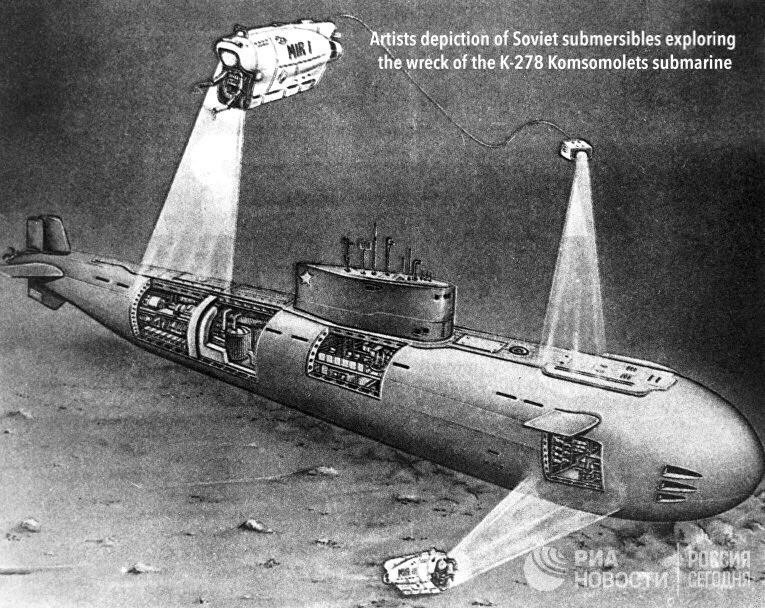Tragedy struck Russia’s one-of-a-kind submarine, the K-278 Komsomolets, when a fire broke out in the vessel while it was still submerged deep in the frigid depths of the Arctic Ocean near Norway three decades ago. The vessel could never be recovered, but unfortunately, it releases radioactive substances into the sea.
A nuclear-powered attack submarine, the K-278 Komsomolets, was one of the prized possessions of the Soviet Navy. One of the first submarines to have a titanium hull, it was commissioned in 1983 and could dive significantly deeper than any of its rivals, reaching depths of less than 3,000 feet. It was believed to be one of its kind.
Although the Soviet Navy commissioned it to test the technology for the fourth generation of Russian nuclear submarines, the K-278 was also equipped to deploy and maneuver in combat, especially since it was traversing the waters during the Cold War period.
The K-278 Komsomolets was longer than a football pitch at 117 meters and weighed 8,000 tons submerged. The giant submarine could be handled by merely fifty-seven to sixty-four officers and crew thanks to sophisticated automated technologies.
It had a double hull, with the inner one made of titanium, giving her a much greater operating depth than the finest American submarines. The pressure hull had seven compartments, the second and third of which were shielded by stronger bulkheads at the front and back, forming a “safety zone” in an emergency.
An escape capsule was installed in the fin to allow the crew to leave the ship in the event of an underwater emergency. However, when an emergency struck, the safety measures incorporated into the design of this mighty Soviet submarine did little to save the lives of the crew trapped inside.
Today, this iconic submarine lies dormant on the bottom of the sea in one of the world’s richest fishing regions. The vessel’s hull and the casings protecting its nuclear weapons have been corroding over time due to the seawater, and radioactive material has been leaking into the ocean.
What Transpired On That One Fateful Day?
Launched in June 1983, Komsomolets conducted tests and trials the following four years. Under the command of Captain Yuri Zelenskiy, she made the deepest dive ever by an armed military submarine in the Sea of Norway in 1984, plunging 1,020 meters (3,350 ft) below the surface. In April 1989, Captain Evgeny Vanin eventually sent the Komsomolets on her first mission. Unfortunately, it was also her last.
On April 7, the submarine was buried 386 meters under the Sea of Norway. An electrical short caused a fire in the boat’s aft due to the rupture caused by the high-pressure airlines joining the submarine’s ballast. These forcefully hurled eight thousand psi of air around, harming an oil system.
Shortly after, the oil spilled onto a heated turbine, triggering a fire. Making matters progressively worse for the submarine and its crew, the pressurized air gouts fueled the advancing fire, which tripped the nuclear reactor’s emergency shutdown and knocked out power to the submarine’s hydraulics.
Captain Vanin attempted to shut the rear compartment after losing contact with the engine room, but the fire still spread into nearby compartments due to bulkhead cable penetration. The captain desperately requested a ballast tank emergency blast to pull Komsomlets back to the surface.
As the tragedy unfolded aboard the USSR’s most technologically advanced submarine, captain Vanin, and five other crew members remained onboard to save the sinking submarine. In contrast, the majority of the crew fled to the deck.
At the bottom of the Norwegian Sea rests the K-278 Komsomolets & her nuclear payload
–@KyleMizokami/@TheNatlInteresthttps://t.co/Q6YXDNzOtO pic.twitter.com/RLU9RVZwJe— Strategy Matters (@MT_Strat) July 22, 2017
However, leaking pressurized air only made the fire worse. When K-685 started to resurface under the water at 4:30 p.m., Captain Vanin ordered the crew above to leave the ship. While their sixth companion was lost inside the submarine’s murky confines, he and four officers boarded the special escape pod.
Two crew members were killed, and another two, including the captain, were rendered comatose when the escape hatch decompressed explosively after ascending to the surface due to a defect in the system.
According to CIA documents, the Soviet Navy hesitated to dispatch a rescue mission despite having hours of notice, initially dropping rafts by helicopter for the survivors.
A civilian floating fish factory arrived an hour and twenty minutes later. Still, it was too late for twenty-three of the Komsomolet’s crew, of which thirty-four died of hypothermia in the icy waters of Norway.
Russia erupted with outrage as forty-two of the sixty-nine crew members aboard had died, the majority of them after they had successfully escaped the ship. An inquiry into the incident was launched in the aftermath of the accident.
Nine years later, an inquiry concluded with no suspects. At the time of the accident, two nuclear-armed missiles were mounted on the deep-diving Komsomlets, which had descended 1,680 meters to the ocean floor.
As time passed, the broken hull of the ship was frequently examined for contamination by Scandinavian governments for years until minor indications of plutonium leaking were found during an examination in 1994.
Fortunately, later examinations only discovered a small amount of new contamination after fixing some breaches and leaks.
However, a couple of years ago, media reports suggesting a consistent radioactive leak created hysteria.

Russian Sub’s Radioactive Leaks – Not A Good News!
In 2019, fresh saltwater samples were taken from the area surrounding the wreck of the submerged Soviet Project 685 nuclear-powered submarine K-278 Komsomolets, one of which was 100,000 times more radioactive than uncontaminated water. A joint Russian-Norwegian research team took the samples.
At the time, it was observed that the submarine, which had been submerged in the Barents Sea for more than three decades, was actively emitting radiation from its reactor or a pair of nuclear-tipped weapons.
About 100 nautical miles southwest of Norway’s Bear Island in the Barents Sea, the sub is at a depth of more than 5,500 feet and is at rest. Before the researchers received the sample that resulted in the abnormally high radiation level, two others returned with flawless, normal results.
Hilde Elise Heldal, a researcher from the Institute of Marine Research, said in a press release, “It is important that the monitoring of the nuclear submarine continues so that we have updated knowledge about the pollution situation in the area around the wreck. The monitoring helps to ensure consumer confidence in the Norwegian fishing industry.”
Although there has never been any proof of a leak, there have been multiple excursions to explore the site since the tragedy, and they have progressively shown high radiation levels near the boat.
A Russian inspection in 1992 discovered fissures along the whole length of the hull, and it’s challenging to think the submarine has not gotten worse in the years after it sank. Russian officials urged routine monitoring of the wreckage several times between 1993 and 1994, warning that the hazards of radioactive leaking would only grow with time.
However, experts have cautioned that given the depth of the wreck and the minimal number of sea life there, the danger from any radioactive leaks in the boat may have been negligible. Heldal underlined her confidence in the continued safety of the area for Norwegian fishermen.
Shortly after Heldal’s comments, however, a new set of findings were published. It noted that one of the saltwater samples recovered from the Komsomolets wreck was 800,000 times more radioactive than uncontaminated water.
Whether the leak was from the nuclear reactor or the torpedoes remains unknown. Still, the research team’s evaluations of the disaster’s dangers to local commercial fishing and sea life in general did not change.
“What we have measured has minimal impact on Norwegian fish and seafood,” Hilde Elise Heldal, one of the Institute of Marine Research researchers, said. “Levels [of radioactivity] in the Norwegian Sea are generally shallow, and the pollution from Komsomolets is quickly diluted to harmless levels because the wreck is at such deep water.”
Norwegian Radiation and Nuclear Safety Authorities (DSA) and the Norwegian Institute of Marine Research (IMR) have been observing and testing the seas along the wreckage since the early 1990s.
Any leakage that has occurred so far has been at amounts that do not hurt the environment. Scientists believe the main reason is that the ship is so far below the sea’s surface that the pollution is diluted before it becomes dangerous.
- Contact the author at sakshi.tiwari9555 (at) gmail.com
- Follow EurAsian Times on Google News




